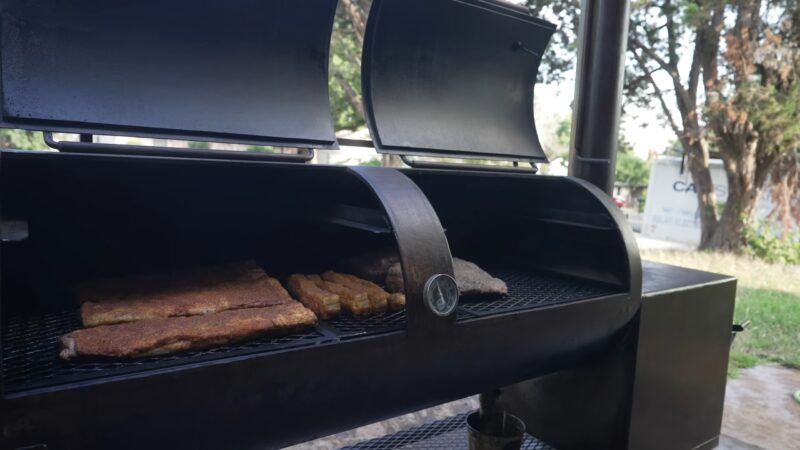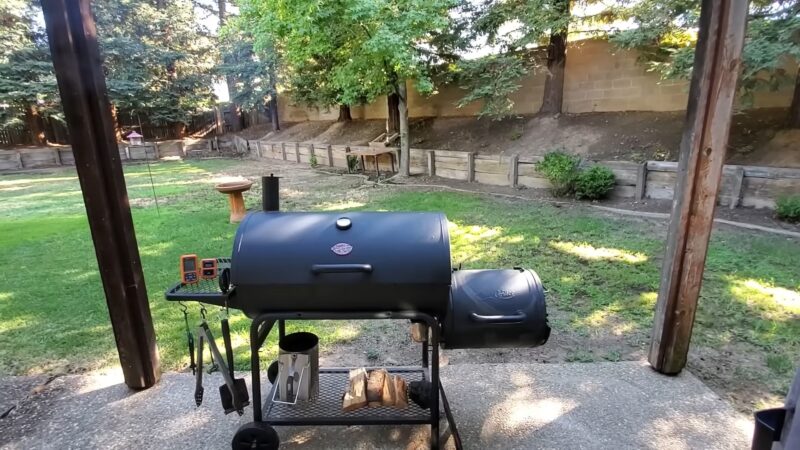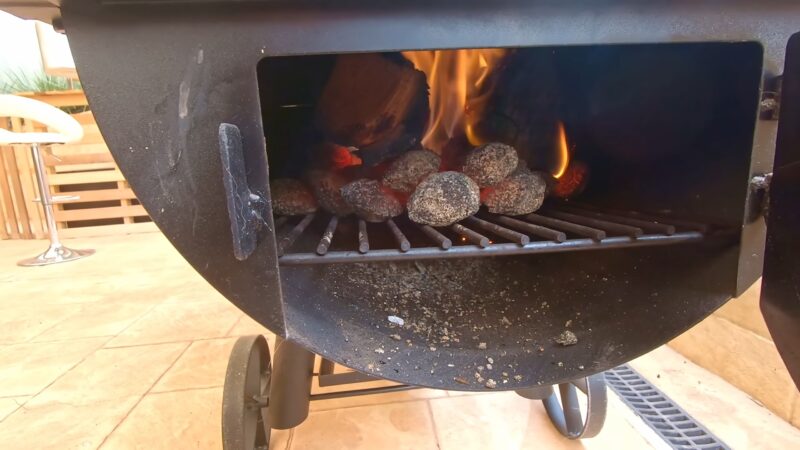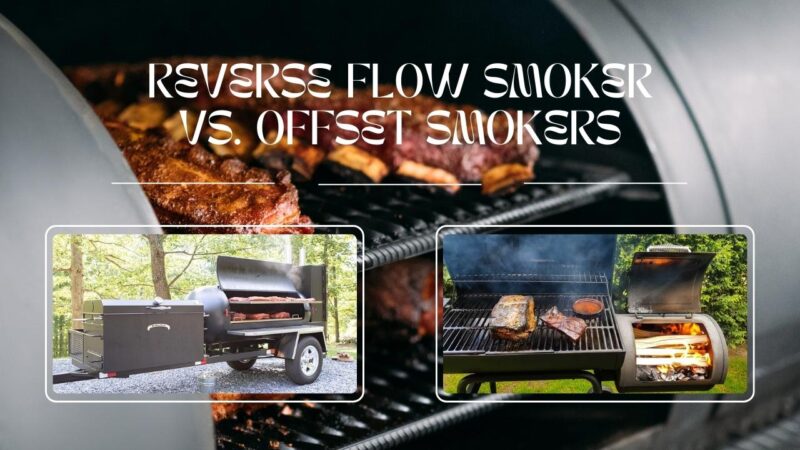Ah, the world of barbecue and smoking! It’s not just about meat anymore, we can also infuse that smoky flavor into vegetables, tofu, and more. The growing interest in different smoker types has opened up a new culinary world, and it’s not just about the taste; it’s about the skill, the art, and the joy of cooking.
In this world of smoky flavors, two types of smokers have caught the attention of pitmasters and hobbyists alike: reverse flow and offset smokers. Each has its unique characteristics, and understanding them can greatly affect the level of skill required to master them.
So, whether you’re a seasoned pitmaster or just starting your smoky journey, let’s explore these fascinating smoker types.
Reverse Flow Smokers

Sounds intriguing, doesn’t it? Well, let’s break them down.
They are designed with a metal plate that directs the smoke and heat from the firebox to the far end of the smoker. Then, it reverses the flow back across the food to the chimney. This design ensures even heat distribution, making it a favorite among many.
| Advantages | Disadvantages |
| Even heat distribution | Generally more expensive |
| Less likely to have hot spots | Heavier and harder to transport |
| Great for beginners and experts | Limited availability in some areas |
Advantages and Disadvantages
The reverse flow design offers consistent temperature control, making it easier for beginners. However, they can be more expensive and heavier, which might not suit everyone.
- Even Cooking: The reverse flow design helps in even cooking, making it ideal for smoking large vegetables or even a whole cauliflower.
- Fuel Efficiency: These smokers are known to be more fuel-efficient, saving both money and resources.
Cooking with Reverse Flow
Cooking with a reverse flow smoker is like conducting a symphony; it requires precision, but oh, the results are worth it!
While the design makes them more forgiving, mastering them requires understanding the nuances of temperature control and smoke flow.
Tips and Techniques for Beginners

- Start Small: If you’re new to smoking, start with something simple like smoked tofu or portobello mushrooms.
- Monitor Temperature: Keep a close eye on the temperature to ensure even cooking.
- Experiment with Woods: Different woods impart different flavors. Try applewood for a sweeter taste or hickory for something more robust.
Every smoker has its quirks, and reverse flow are no exception. The weight and cost might be a barrier for some, but the control and consistency they offer can make them an excellent investment.
[su_note note_color=”#93e6b7″]Fun Fact: Did you know that reverse flow smokers are sometimes called “the forgiving smokers”? Their design helps in reducing common mistakes, making them a favorite among beginners.[/su_note]
Getting to Know Offset Smokers

Now, let’s shift our focus to the other star of the show: Offset Smokers. These traditional beauties have been a staple in the world of barbecue for years.
An offset smoker consists of two main parts: the cooking chamber and the firebox. The firebox generates heat and smoke, which then travels into the cooking chamber where the food is placed. The design is simple but offers a wide range of possibilities.
- Quality Matters: Invest in a well-built offset smoker with thick metal; it retains heat better.
- Control the Fire: Mastering the firebox is key. Experiment with coal and wood combinations for unique flavors.
| Advantages | Disadvantages |
| Versatility in cooking | Requires more skill and attention |
| Can be used as a grill | Potential for uneven heating |
| Wide availability | Can be expensive for quality ones |
Advantages and Disadvantages
They offer versatility but require a keen eye and a skilled hand to manage the fire and temperature. They can be a joy for experienced pitmasters but might pose a challenge for beginners.
The Learning Curve
The journey with an offset smoker is like a dance; it takes time to learn the steps, but once you do, it’s a performance to remember.
They demand attention, patience, and practice. The manual control over the firebox means that you’re in charge of the heat and smoke, which can be both empowering and challenging.
Advice for Beginners
- Patience is Key: Learning to control the temperature takes time. Start with forgiving foods like smoked tempeh or seitan.
- Learn from Mistakes: Every mishap is a lesson. Keep a smoking journal to note what works and what doesn’t.
- Join a Community: Connect with fellow smoking enthusiasts online or in local clubs. Sharing experiences can accelerate learning.
[su_note note_color=”#93e6b7″]Fun Fact: Some pitmasters refer to their offset smokers as “The Beast” due to the level of skill and attention they demand.[/su_note]
Comparing Required Skill Levels
Now that we’ve explored both types, let’s put them head to head.
| Aspect | Reverse Flow Smokers | Offset Smokers |
| Ease of Use | Suitable for beginners | Requires more skill |
| Temperature Control | More consistent | More manual control needed |
| Versatility | Specific to smoking | Can be used for grilling too |
Factors Influencing the Learning Curve
- Personal Preference: Some may enjoy the hands-on experience of an offset smoker, while others prefer the consistency of reverse flow.
- Budget: Quality offset smokers can be pricey, but so can reverse flow models. Consider what you’re willing to invest in terms of money and time.
- Real-life Experiences: Talk to pitmasters who have used both. Their insights can guide your choice.
Tips for Advancing Your Smoking Skills

Whether you choose a reverse flow or an offset smoker, the journey towards becoming a skilled pitmaster is filled with excitement, experimentation, and, of course, delicious flavors. Here are some general tips to help you along the way:
- Practice, Practice, Practice: The more you smoke, the better you’ll get.
- Experiment with Flavors: From different woods to unique marinades, don’t be afraid to try new things.
- Connect with Others: Join forums, attend workshops, and share your experiences with fellow enthusiasts.
FAQ
Can I smoke vegetables in them?
Absolutely! From eggplants to tofu, the possibilities are endless.
Which one is best for beginners?
Many find reverse-flow smokers more forgiving, but personal preference plays a role too.
How do I maintain my smoker?
Regular cleaning, proper storage, and following the manufacturer’s instructions are key.
Conclusion
The world of smoking is rich and diverse, offering flavors and experiences that are truly unparalleled. Whether you choose the consistency of a reverse flow smoker or the versatility of an offset smoker, the journey is yours to embark on.
Embrace the learning curve, savor the flavors, and most importantly, have fun with it. Happy smoking, fellow plant-based pitmasters!
